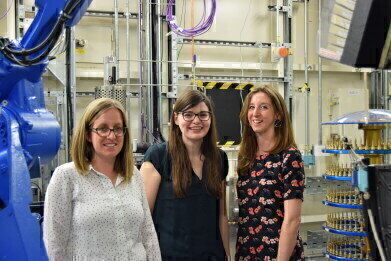-
 Julia Parker, Claire Murray and Laura Holland on the beamline prior to the experiment
Julia Parker, Claire Murray and Laura Holland on the beamline prior to the experiment
News
Diamond’s Largest Public Engagement Project Completes Beamtime
May 11 2017
Project M, the UK synchrotron Diamond Light Source’s biggest ever public engagement project, completed analysis of 771 calcium carbonate samples in a 24 hour period at the end of April.
Having asked students from 100 schools across the UK to prepare the samples, Diamond scientists Claire Murray and Julia Parker completed the mammoth task of analysing the 1,000 samples sent back on the 26th and 27th April, using the high-resolution powder diffraction beamline I11.
“Calcium carbonate has three main forms, or ‘polymorphs’: vaterite, calcite, and aragonite,” said Dr Julia Parker. “We’ve asked each of the schools taking part in Project M to produce samples using specially selected additives and we’re trying to find out which of the polymorphs form for each of the additives.”
Claire Murray explained the range of work from across Diamond that went into Project M. “A project like this required custom built software by Karl Levik, Peter Holloway, Mark Basham, Jacob Filik, Stuart Fisher and Alun Ashton as well as hardware upgrades which were carried out by Jonathan Potter, Ronaldo Mercado and Dave Bond. In addition we had a fantastic team of scientists including Annabelle Baker, Sarah Day, Anna Herlihy, Dean Ottewell, Stephen Thompson and Chiu Tang, who helped us prepare all of the equipment and the samples for the experiment. We also had some fantastic support from Rebecca O’Brien at the Wellcome Trust who helped develop the schools packs.
“All of this made it possible for the schools to carry out their experiment and also to understand their results, both of which were critical to the project’s success,” Claire Murray continued. “We have been so impressed by how engaged and enthusiastic the students have been and we were delighted to see schools discussing the experiment with their local media.”
“Despite being the 4th most common substances on the planet, there’s so much we don’t understand about calcium carbonate,” added Julia Parker. “Nature can make almost anything from it, from the white cliffs of Dover to the spine of a sea urchin, yet we’re only able to form the crystals into cubes in the laboratory.”
The data is now being sent back to the students who prepared the samples – and it’s hoped that this will lead to a scientific paper, as this research has never been done before.
For more information about Project M, visit: www.diamond.ac.uk/ProjectM
Digital Edition
Lab Asia Dec 2025
December 2025
Chromatography Articles- Cutting-edge sample preparation tools help laboratories to stay ahead of the curveMass Spectrometry & Spectroscopy Articles- Unlocking the complexity of metabolomics: Pushi...
View all digital editions
Events
Jan 21 2026 Tokyo, Japan
Jan 28 2026 Tokyo, Japan
Jan 29 2026 New Delhi, India
Feb 07 2026 Boston, MA, USA
Asia Pharma Expo/Asia Lab Expo
Feb 12 2026 Dhaka, Bangladesh


















